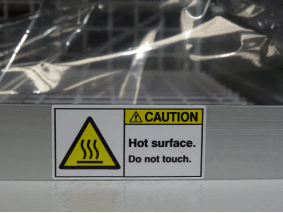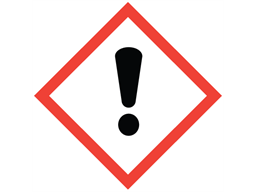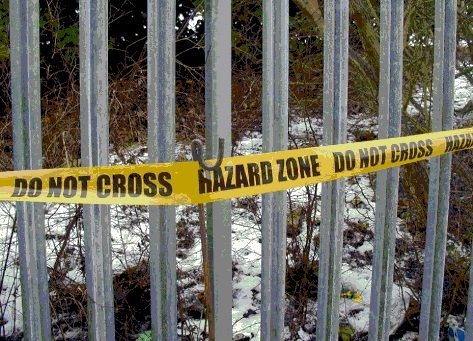
If you need to stock up on ANSI labels, we at Label Source can help - we stock an extensive variety of ANSI safety labels, which can be used to identify the following hazards (among others):
- High voltages
- Crush hazards / pinch points
- Harmful chemicals
- Hot surfaces
- Environments that necessitate the use of PPE (Personal Protective Equipment)
All of our ANSI labels are made of self-adhesive vinyl with a clear polyester laminate. The labels are available in two different sizes (25mm x 50mm and 50mm x100mm), and we supply them in packs of 100 labels each.
What is ANSI?
ANSI stands for the American National Standards Institute. This organisation is responsible for a huge number of different standards in use throughout the United States; they also work to co-ordinate American standards with international standards to ensure that products manufactured in the USA can be used in other countries.
Our ANSI Safety Labels
The labels in our ANSI range are specifically made to comply with the American National Standards Institute's guidelines for health and safety labelling. Each one looks something like this:
The top-right part of the label will usually say WARNING, DANGER or CAUTION. Underneath this is a description of the hazard in question (e.g. 'Pinch point') and/or a set of safety instructions for those who might come into contact with this hazard (e.g. 'Keep hands clear'). The left-hand side of the label is occupied by a universally-recongisable hazard warning symbol; these symbols are identical to those used in the United Kingdom and the EU in accordance with ISO EN 1710 and the Safety Signs and Signals Regulations 1996.
Click here to browse our collection of ANSI labels, or visit our Safety Labelling department to view our full range of hazard warning labels.

Britain worked itself up into a lather last week when it was announced that, under new EU legislation, the makers of Fairy Liquid would have to print a GHS harmful/irritant warning on all bottles starting from June 2017. News outlets like the Daily Mail were quick to paint this story as yet another example of Brussels bureaucrats terrorising the British way of life - here's the headline from www.dailymail.co.uk:
Procter and Gamble, the manufacturers of Fairy Liquid, have expressed their anger at this ruling, which they worry will discourage people from using their product and contradict the brand's long-established 'soft on skin' image.
However, it should be pointed out that washing-up liquid (including "beloved and quintessentially British brand" Fairy Liquid) is, in fact, hazardous if misused. As the Mail themselves point out, the required GHS label (a black exclamation mark inside a red border) will warn consumers that Fairy Liquid may cause "eye irritation, respiratory tract irritation, and have narcotic effects". All of which is true - even soft, kind Fairy Liquid should not be ingested, inhaled, or allowed to make contact with the eyes.
The potential hazards of washing-up liquid need to be clearly marked on the products to promote safe use, and this is all that the new EU legislation aims to achieve. Instead of criticising the move, news outlets would do better to educate their readers as to the exact meaning of GHS labels and the ways in which labelled products can and can't be safely used. It's time to stop criticising health and safety culture and start helping to keep people safe!
See also:
Where can a non-adhesive hazard tape be used?

When we say 'hazard tape', you probably think of self-adhesive tapes, which are mainly used for floor marking purposes. However, we do sell another type of hazard tape here at Label Source: our non-adhesive barrier tape, suitable for a wide variety of applications and available in many different designs.
Here are some of the ways in which our non-adhesive hazard tapes are most commonly utilised:

Barrier tape is a common sight in the construction industry. This particular product is designed to warn of underground sites - manholes, dug-up roads, et cetera - but we also stock a variety of non-adhesive hazard tapes for overground construction sites.

Police forces and other authorities often use non-adhesive hazard tape to cordon off crime scenes and prevent unauthorised personnel from accessing the site in question.

A non-policial equivalent of the above. Where the police tape is used to restrict access to crime scenes, this non-adhesive hazard tape can be used for more informal purposes: for example, a security line can be used for crowd control purposes at sporting matches and promotional events.
All of these non adhesive hazard tape products (and many more) can be found in our Printed Barrier Tape section. We also sell plain barrier tapes and chevron barrier tapes.
Electricity can kill! If hazards from electricity in the workplace are not clearly displayed, accidents can occur and some may even lead to death, as well as causing damage to property. People working within certain industries can be exposed to electricity more than others, and these are the people who are more likely to have an accident, especially if they are not informed of the dangers, and take the necessary precautions. However, virtually all companies have exposure to electricity to some extent, particularly with computers and printers.
It was reported that well over 100 accidents a year in the UK are due to electric shocks, with 89 serious injuries and 6 fatalities (in 2010/2011). Exposure to live electrical equipment can cause respiratory failure, heart attacks, electrical burn injuries and seizures. Other physical injuries can be caused by tripping over trailing wires or leads.
If there is any potential hazards in the workplace then count on us for your electrical safety signs. Our signs and labels will help identify the dangers, clearly informing and warning staff or building users of the potential risks from electricity. Our labels and signs inform workers of the voltage of the appliance (whether high or low voltage), live wires and terminals, electrical cables (overhead or underground), safety connections, isolation and safety devices, electrical arcing, and inspection labels, amongst others. An electric shock notice is also available to help inform workers of the actions needed to be taken in the event of injuries from contact with powered equipment, with recommended treatment guides including resuscitation, location of first aid equipment and emergency contact details.
So if you come into contact with electrical supply equipment, such as switchgear or busbars, cables or conductors, caution should be taken to make sure that the power source is disconnected. All cables, plugs, sockets and isolators should be maintained and checked regularly by competent personnel.
Make sure your workplace remains safe from electrical hazards, with our range of signs and labels providing a constant visual reminder of the need to take care when in contact with electrical equipment.